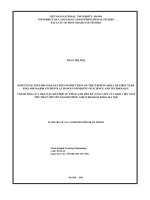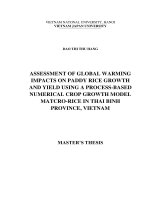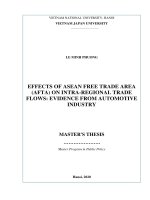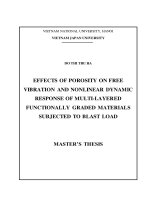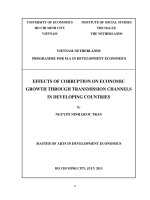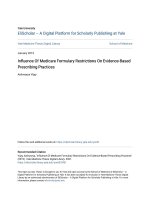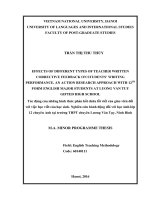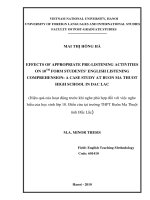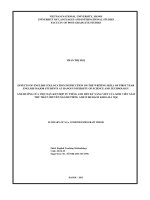Luận văn thạc sĩ effects of schema based activities on EFL learners reading comprehension
Bạn đang xem bản rút gọn của tài liệu. Xem và tải ngay bản đầy đủ của tài liệu tại đây (2.18 MB, 130 trang )
MINISTRY OF EDUCATION AND TRAINING
QUY NHON UNIVERSITY
NGUYEN PHUONG NGAN
EFFECTS OF SCHEMA-BASED ACTIVITIES ON
EFL LEARNERS’ READING COMPREHENSION
Field: Theory and Methodology of English Language Teaching
Code: 8140111
Supervisor: Assoc. Prof. Dr. Nguyen Quang Ngoan
Binh Dinh - 2022
BỘ GIÁO DỤC VÀ ĐÀO TẠO
TRƯỜNG ĐẠI HỌC QUY NHƠN
NGUYỄN PHƯƠNG NGÂN
ẢNH HƯỞNG CỦA CÁC HOẠT ĐỘNG HOẠT HÓA
KIẾN THỨC NỀN ĐỐI VỚI KHẢ NĂNG ĐỌC HIỂU
CỦA NGƯỜI HỌC TIẾNG ANH
Ngành: Lý luận và phương pháp dạy học bộ môn Tiếng Anh
Mã số: 8140111
Người hướng dẫn: PGS. TS. Nguyễn Quang Ngoạn
Bình Định - 2022
i
STATEMENT OF AUTHORSHIP
I declare that the information reported in this study is the result of my
own work and effort, except where due reference is made. The thesis has not
been accepted for any degree and is not concurrently submitted to any
candidature for any degree or diploma.
Binh Dinh, August 2022
Nguyen Phuong Ngan
ii
ACKNOWLEDGEMENTS
During the process of doing this thesis, I have received invaluable
support, precious ideas and timely encouragements from my supervisor, family
and friends. This paper could not have been successfully completed without
their helps, encouragement and contributions. I take this chance to appreciate
them for their expert advice and wise comments and generous time.
First and foremost, I am grateful to my supervisor, Assos. Prof. Dr.
Nguyen Quang Ngoan, for his amazing supervision. His outstanding
knowledge, professional teaching-related expertise, kind support and
continuous assistances went through the process of doing this thesis. His
encouragement and comment had significantly enriched and improved my
work. I appreciate his accommodating guidelines and suggestions, great
patience, and strong management skills in helping me resolve obstacles when I
carried out my thesis. I feel fortunate to have had him support my work.
This study was made achievable by the presence of the enthusiastic
students at Au Viet Center in Khanh Hoa Province, who devoted their time
taking part in this research. I am also thankful to my colleagues for their
fascinating assistance, support and management during the pilot phase.
Last but not least, a special thank is given to my beloved parents and
sister for their encouragement and support throughout thesis education.
iii
ABSTRACT
Reading comprehension is one of four important skills in learning any
languages. However, many learners still have difficulties in improving their
reading comprehension. This research aims at investigating the effects of
schema-based activities on EFL learners’ reading comprehension. The research
employed a quasi-experimental method in a mixed-method design with the
participation of 80 EFL tenth-grade learners in an English center in Khanh Hoa
Province. These participants were divided into 2 groups: control group and
experimental group. Three research instruments were two reading
comprehension tests, a questionnaire and a semi-structured interview. The
findings showed that schema-based activities have positive effects on learners’
reading comprehension such as increasing reading speed, motivating interests,
providing real-world knowledge and specific purposes before reading, and so
on.
Keywords:
schema
comprehension
activation,
schema-based
activities,
reading
iv
TABLE OF CONTENTS
STATEMENT OF AUTHORSHIP ................................................................... i
ACKNOWLEDGEMENTS .............................................................................. ii
ABSTRACT ..................................................................................................... iii
TABLE OF CONTENTS ................................................................................. iv
LIST OF TABLES ......................................................................................... viii
LIST OF FIGURES........................................................................................... x
LIST OF ABBRREVIATIONS ....................................................................... xi
CHAPTER 1. INTRODUCTION ..................................................................... 1
1.1. Rationale ................................................................................................ 1
1.2. Aim and objectives of the study ............................................................ 2
1.3. Research questions ................................................................................ 3
1.4. Significance of the study ....................................................................... 3
1.5. Scope of the study.................................................................................. 4
1.6. Definitions of terms ............................................................................... 4
1.7. Structure of the thesis ............................................................................ 4
CHAPTER 2. LITERATURE REVIEW .......................................................... 6
2.1. Reading comprehension ........................................................................ 6
2.1.1. Definitions ...................................................................................... 6
2.1.2. Reading comprehension approaches ............................................. 7
2.1.3. Reading comprehension teaching and learning .......................... 10
2.1.4. The importance of English language reading ............................. 12
v
2.1.5. Reading testing and assessment ................................................... 13
2.2. Schema Theory .................................................................................... 14
2.2.1. Definitions .................................................................................... 14
2.2.2. Types of schemas.......................................................................... 15
2.3. Schema-based activities and reading comprehension ......................... 17
2.3.1. The effects of schema-based activities on reading comprehension
................................................................................................................ 17
2.3.2. Pedagogical implication of schema-based activities in reading
comprehension ....................................................................................... 19
2.4. Related studies on applying schema activation to teach L2 reading
comprehension ............................................................................................ 22
CHAPTER 3. RESEARCH METHODOLOGY ............................................ 28
3.1. Research aim and hypotheses .............................................................. 28
3.1.1. Research questions....................................................................... 28
3.1.2. Hypotheses ................................................................................... 28
3.2. Research design ................................................................................... 29
3.3. Participants .......................................................................................... 30
3.3.1. Teacher......................................................................................... 30
3.3.2. Students ........................................................................................ 30
3.4. Material and time frame ...................................................................... 31
3.4.1. Material and lesson plan ............................................................. 31
3.4.2. Time frame ................................................................................... 32
3.5. Instruments .......................................................................................... 32
vi
3.5.1. Reading comprehension tests....................................................... 33
3.5.2. The questionnaire......................................................................... 34
3.5.3. The semi-structured interview ..................................................... 34
3.6. Data collection procedure .................................................................... 35
3.7. Validity and reliability ......................................................................... 36
CHAPTER 4. FINDINGS AND DISCUSSION ............................................ 37
4.1. Students’ achievement in reading comprehension between the control
group and experimental group before and after the intervention ............... 37
4.1.1. Students’ achievement in reading comprehension between the two
groups before the intervention ............................................................... 38
4.1.2. Students’ achievement in reading comprehension between the two
groups after the intervention .................................................................. 39
4.2. Students’ achievement in reading comprehension within the
experimental group before and after the intervention ................................ 41
4.2.1. Students’ reading comprehension difference between the pre-test
and post-test ........................................................................................... 41
4.2.2. Students’ reading comprehension detailed score in the pre-test and
post-test .................................................................................................. 42
4.2.3. Students’ performance in each part of the reading comprehension
tests ......................................................................................................... 43
4.3. Students’ attitudes towards the use of schema-based activities in
learning reading comprehension................................................................. 45
4.3.1. Students’ time of practicing reading comprehension outside the
class ........................................................................................................ 46
vii
4.3.2. Students’ preferences for each activity ........................................ 47
4.3.3. Students’ attitudes towards the use of schema-based activities in
learning reading comprehension ........................................................... 49
4.3.4. Differences in male and female students’ attitudes towards the use
of schema-based activities in leaning reading comprehension ............. 56
4.4. Students’ understanding of using schema-based activities in learning
English reading comprehension - its benefits, challenges and suggestions57
CHAPTER 5. CONCLUSION AND IMPLICATIONS................................. 63
5.1. Summary of the findings ..................................................................... 63
5.2. Pedagogical implications ..................................................................... 65
5.3. Limitations of the study ....................................................................... 66
5.4. Suggestions for further studies ............................................................ 67
REFERENCES ................................................................................................ 68
APPENDICES................................................................................................. 76
viii
LIST OF TABLES
Table 3.1. Background of the participants ............................................ 30
Table 3.2. General lesson plans for teaching two groups ..................... 31
Table 3.3. Reading comprehension tests format ................................... 33
Table 4.1. Reliability of the pre-test and post-test of the two groups ... 37
Table 4.2. Students’ achievement in reading comprehension between the
control and experimental group before the intervention ....................... 38
Table 4.3. Difference in the pre-test between the two groups .............. 38
Table 4.4. Students’ achievement in reading comprehension between the
control and experimental group after the intervention .......................... 39
Table 4.5. Difference in the post-test between the two groups............. 40
Table 4.6. Difference between the pre-test and post-test within the experimental
group...................................................................................................... 41
Table 4.7. Mean score of each part of the pre-test ................................ 43
Table 4.8. Mean score of each part of the post-test .............................. 44
Table 4.9. Reliability of all items in the questionnaire ......................... 46
Table 4.10. Time students spent practicing reading comprehension outside
class ....................................................................................................... 47
Table 4.11. Students’ preferences for schema-based activities ............ 48
Table 4.12. Mean score of students’ preferences for each schema-based activity
............................................................................................................... 48
Table 4.13. Overall mean score of students’ attitudes towards the use of
schema-based activities in learning reading comprehension ................ 50
ix
Table 4.14. Students’ overall affective attitudes towards the use of schemabased activities in learning reading comprehension ............................. 50
Table 4.15. Students’ positive affective attitudes towards the use of schemabased activities in learning reading comprehension ............................. 51
Table 4.16. Students’ detailed affective attitudes towards the use of schemabased activities in learning reading comprehension ............................. 51
Table 4.17. Students’ cognitive attitudes towards the use of schema-based
activities in learning reading comprehension ....................................... 52
Table 4.18. Students’ positive cognitive attitudes towards the use of schemabased activities in learning reading comprehension ............................. 53
Table 4.19. Students’ detailed cognitive attitudes towards the use of schemabased activities in learning reading comprehension ............................. 53
Table 4.20. Mean score of male and female students’ attitudes towards the use
of schema-based activities in learning reading comprehension ............ 56
Table 4.21. Difference between male and female learners’ attitudes towards the
use of schema-based activities in learning reading comprehension ..... 56
x
LIST OF FIGURES
Figure 4.1. Summary of participants’ reading comprehension before and after
the intervention ............................................................................ 40 .........
Figure 4.2. Detailed score in the pre-test of the participants in the experimental
group...................................................................................................... 42
Figure 3. Detailed score in the post-test of the participants in the experimental
group...................................................................................................... 42
xi
LIST OF ABBRREVIATIONS
ELF: English as a Foreign Language
ESL: English as a Second Language
MOET: Ministry of Education and Training
L2: second language
1
CHAPTER 1. INTRODUCTION
This chapter gives the introduction for the current study. It includes
seven parts: rationale, aim and objectives, research questions, significance,
scope, definitions of terms, and structure of the thesis.
1.1. Rationale
The field of second and foreign language reading has been revitalized in
the past few years since our understanding of the nature of the reading process.
According to Carrel (1988, p. 1), for many students, reading is by far the most
important skill of the four in L2, especially in ESL or EFL. Students need
reading comprehension to successfully accomplish the educational goals and
expectations, which are required in the classroom settings. Furthermore,
reading has a great function in opening up the horizon of knowledge as well as
vocabulary used every day, which can contribute to other aspects of learning
languages.
Mikulecky and Jeffries (1996, p. 14) state that comprehension is part of
our lives, it makes sense of arriving new information and connecting these ideas
to what he/she already knows. Since reading is a process which happens among
readers’ existing knowledge and ability to understand working information, it
becomes important to make learners ready preceding the reading tasks.
Therefore, an effective method that has been introduced to activate students’
knowledge during pre-reading stage is using schema-based activities. The
theory claims that people need to combine their own background knowledge
with new information in a text to comprehend it (Adams & Collins, 1977, p. 4).
Since this process involves individual experience, it succeeds in attracting
students in reading and thus benefits them in motivating their interests,
increasing their reading speed, and making proper reading judgments.
2
With the context of integration and globalization in Vietnam, training
and improving English proficiency seems to be a top priority. However,
English language teaching in Vietnam has not yet achieved impressive success
as our desire due to several troublesome challenges. One of these problems is
students’ ability in reading comprehension. In fact, reading materials
containing various of vocabulary and unfamiliar topics that can make students
confused and demotivated as they are unable to understand (Ha, 2021). In
addition, many teachers may ignore the impact of their learners’ background
and its role in comprehension. As a result, most students are not aware of what
they are going to read about, what they are going to do with the tasks, and so
on.
The problem is that few studies have been conducted on the field of using
schema-based activities for language teaching and learning reading
comprehension in Vietnam. Consequently, to fill this literature gap, this present
study aims to shed light on the implication of schema-based activities in
teaching reading comprehension and its effects on EFL learners. The study also
finds out the students’ perceptions of using schema-based activities in learning
reading comprehension.
1.2. Aim and objectives of the study
This study aims to examine the effects of schema-based activities on EFL
learners’ reading comprehension.
The detailed objectives are:
• to test the effects of schema-based activities on EFL learners’ reading
comprehension
3
• to investigate the EFL learners’ perceptions of using schema-based
activities in learning reading
1.3. Research questions
In order to achieve the above objectives, the following questions are
proposed:
1. To what extent does the use of schema-based activities affect EFL
learners’ achievement in reading comprehension?
2. What are the EFL learners’ attitudes towards the use of schema-based
activities in learning reading?
1.4. Significance of the study
Although there are several studies about the schema activation in
language teaching that have been proved, few are conducted in Vietnam,
especially in Khanh Hoa Province. Thus, it is essential to conduct this research
because of the following reasons.
Theoretically, the findings of the study may provide a basis for future
researchers based on the use of schema theory. It can also help teachers to have
a clearer understanding of the nature and effects of schema on students’ reading
comprehension.
Practically, based on the results, teachers probably make decisions about
using the schema-based activities in teaching rather than the traditional bottomup activities to engage their learners in. Moreover, learners may incorporate
more of these schema-based activities into their self-study habits. Finally, if
there is a connection between students’ reading comprehension and schemas,
materials developers can include more schema-based activities in their course
4
books to encourage teachers and students to pay more attention to such
activities.
1.5. Scope of the study
Due to the limited time, ability and research conditions, the scope of this
study is confined in a population of 80 grade 10th students from two intact
classes at a language center in Khanh Hoa Province. Therefore, the study’s
generalization would be limited, and the results may not be representative of a
larger same of all EFL students in Khanh Hoa Province.
1.6. Definitions of terms
- reading comprehension: reading comprehension can be briefly as “the process
of making meaning from text” (Wolley, 2011, p. 15).
- schema (plural: schemas or schemata): “schema refers to an active
organization of past reactions, or of past experiences, which must always be
supposed to be operating in any well-adapted organic response” (Barlett, 1932,
p. 201).
- schema theory: “The ‘schemata’ based learning theory indicates that readers
process meaning which has been presented through print by using prior
knowledge of the world to produce representations of anticipated meaning”
(Hudson, 1982, p. 1).
- schema-based activities: additional patterning activities that are needed to
activate stored information and build new connections to successfully
consolidate new and prior knowledge (Kennedy & Ebner, 1996, p. 38).
1.7. Structure of the thesis
The thesis is presented in five chapters: Introduction, Literature Review,
Research Methodology, Findings and Discussion, Conclusion and Implications.
5
Chapter 1, Introduction, presents the rationale, aim and objectives,
research questions, significance, scope, definitions of terms, and the structure
of the thesis.
Chapter 2, Literature Review, explores several underlying theoretical
constructs that framed this study. It also examines the relevant literature
regarding 1) EFL reading comprehension, 2) the use of schema-based activities
in reading comprehension, and 3) related studies on the use of schema-based
activities in language learning.
Chapter 3, Research Methodology, explains the research method. Firstly,
it presents the research questions and the hypotheses of the present study.
Secondly, it describes the research design and participants. Thirdly, it
introduces the research instruments used to collect data and the materials used
for the intervention in detail. Lastly, this chapter comes to an end with the
procedure to conduct the study and the methods of data analysis.
Chapter 4, Findings and Discussion, reports the results of the study.
First of all, the reliability of the instruments is introduced. Afterward, the score
of learners’ reading comprehension between the experimental group and the
control group are compared. Then, the information collected from the
questionnaire are analyzed. Finally, the data of 6 the face-to-face semistructured interviews are analyzed in order to give more explanations for the
findings of the study. It is done along with comparison with previous research.
Chapter 5, Conclusion and Implications, makes a conclusion of the
report of the study. First, it summarizes the main findings. Then, it suggests the
research implications. Finally, the limitations of the study and the suggestions
for future research are the last part of this chapter.
6
CHAPTER 2. LITERATURE REVIEW
This chapter reviews the literature knowledge related to reading
comprehension, schema-based activities and previous studies on using schemabased activities to teach English skills.
2.1. Reading comprehension
2.1.1. Definitions
To begin with, discussing on the reading concept, a large number of
researchers have offered different definitions. Reading is a complex interaction
of cognitive process and strategies used by the readers with different types of
information in the reading text (Dole et al., 1991, p. 241; Hedgcock & Ferris,
2018, p. 61). Similarly, Benati (2020, p. 236) claims that “reading considered
an interactive process between the reader and the text. The text presents letters,
words, sentences, and paragraphs that encode meaning. The reader uses
knowledge, skills, and strategies to determine what that meaning is”. In
addition, Nuttall (1996, p. 2) adds reading is a process which involves decoding
words and identifying meaning of a text functionally.
Comprehension what is being read is more than just recognizing and
decoding words, this process means readers are able to make sense of what they
are reading and connect these information in the text with what they have
already known (Mikulecky & Jeffries, 2007, p. 74). So, reading comprehension
is considered as the primary purpose for reading (Grabe, 2002, p. 277). It can
be simply understood as ‘reading and understanding’.
Regarding reading comprehension, there are numerous definitions
proposed by different scholars. Ahmadi et al. (2013, p. 238) refer reading
comprehension as the ability of readers to understand both the surface and
7
hidden meanings of the text by using meta-cognitive reading strategies. More
specifically, reading comprehension can be seen as the reader’s ability to use
and apply suitable skills as well as strategies to comprehend a text successfully
(Benati, 2020, p. 236). He also mentions that to comprehend a written text,
readers must recognize and construct the meaning of the words. Sharing the
same idea as Benati, Kennedy & Ebner (1996, pp. 127–128) and Macceca
(2014, p. 5) believes that reading comprehension refers to understanding what
is read, so readers must predict or think ahead; they do not just identify words,
but must be able to cognitively process the words by getting meaning from their
background knowledge and prior experience. The goal, thus, is to gain a general
understanding of what is mentioned in the text rather than to recognize meaning
from isolated words or sentences.
From all definitions above, in my view, it can be concluded that reading
cannot be understood as a simple activity of decoding letters and words. Instead,
reading comprehension is a meaning construction activity which requires a
good interaction between the reader and the text. To do this, readers should
have basic knowledge like vocabulary, grammar, skills as well as background
information.
2.1.2. Reading comprehension approaches
Developing learners’ reading comprehension is the process of
constructing meaning from a written text. It involves making use of learners’
prior knowledge as well as thinking and reasoning. In the development of
reading skills, Alderson (2000, p. 16), Benati (2020, p. 236) and Camp &
Richard (1992, p. 87) point out two processing approaches that affect the ability
of reading comprehension: bottom-up and top-down approaches.
8
In bottom-up approach (traditional view), reading is considered as a
passive (Alderson, 2000, pp. 16–17; Carrell & Eisterhold, 1983, p. 557) or
simply a process of decoding the linguistics information (e.g., orthographic
knowledge, lexical and syntactic knowledge) from the small to large units in a
text. Concerned this approach, Cambourne (1979), who uses the term ‘outsidein’ instead of bottom-up, believes that the reader processes each word as it is
encountered, then the process of this approach works is presented as follow:
Print → Every letter discriminated → Phonemes & graphemes matched →
Blending → Pronunciation → Meaning
In contrast, in top-down approach (cognitive view), reading is believed
as an active process (Dole et al., 1991; Rumelhart, 1980, p. 242) in which
learners process beyond the analysis of linguistics information (e.g., knowledge
of text structure) and background knowledge (e.g., topics’ familiarity) to
understand the text. A typical statement of this can be found in Schank (1978,
p. 94).
“We would claim that in natural language understanding a simple rule is followed.
Analysis proceeds in a top-down predictive manner. Understanding is expectation
based. It is only when the expectations are useless or wrong that bottom-up
processing begins.”
Cambourne (1979) also provides the schematization of this approach
which shows the reconstruction of meaning rather than decoding form:
Past experience, language intuitions and expectations → Selective aspects of
print → Meaning → Sound, pronunciation if necessary
Nuttall (1996, pp. 16–17) compares top-down approach to an eagle’s eye
view of the landscape, and the reader is like this eagle. That means the eagle
can see a wide area spread out from a great height, then it can understand and
9
observe general patterns and the relationships between many parts on the
ground. While she views bottom-up processing as ‘tunnel vision’, she also
gives a specific image of bottom-up processing which might be a scientist using
a magnifying glass to examine the ecology of a transect – a tiny part of the
landscape the eagle surveys.
Both top-down and bottom-up processing are “complementary ways of
processing a text” (Nuttall, 1996, p. 16). Both of them are used whenever we
read, sometimes one dominates, and sometimes the other, but both are needed
(Nunan, 1991, p. 63; Nuttall, 1996, p. 16). However, both approaches still have
their own shortcomings. “One reason for the survival of bottom-up approach in
the face of criticism is that it seems a reasonable and logical explanation of
what happens when we read” and top-down model may not be used to
“distinguish adequately between beginning readers and fluent readers” (Nunan,
1991, pp. 64–66).
Nuttall (1996, p. 17) offers a combination of bottom-up and top-down
approach which is called ‘interactive approach’ (metacognitive view) or
‘balanced approach’ (Birch, 2007, p. 4) to deal with the shortcomings in two
above models. In this approach, reading is an interactive act and readers are not
passive participants in the reading process. The reading process now adopts a
top-down approach to predict the possible meaning, then move to the bottomup approach to check if the prediction fixes the writer’s purpose (Nuttall, 1996,
p. 17). As a result, the difficult levels of a text depend on the linguistic
information and the readers’ background knowledge.
All in all, there are three reading comprehension approaches suggested
by different scholars: bottom-up, top-down and interactive approaches. Among
10
them, interactive approach is considered as the most effective processing of
written text (Carrell & Eisterhold, 1983; Rumelhart, 1980).
2.1.3. Reading comprehension teaching and learning
Goodman (1967, pp. 131–132) believes that reading can be considered
as a ‘psychologistic guessing game’ which requires readers to guess and predict
before reading and activate their background knowledge, then confirm their
guesses, and reconstruct the meaning. As a result of such a view of reading,
learners are taught to become active readers (Juan & Flor, 2006, p. 264), that
is, predicting and guessing the text meaning by using their language knowledge
and background knowledge. Similarly, “teachers who model reading skills and
strategies, facilitate student performances of these abilities in comprehending
texts and provide students with many opportunities for practice are encouraged
in a number of comprehension-enhancing approaches – the best known of
which are reciprocal teaching, cooperative learning and reading recovery”
(Grabe, 2002, p. 277).
Grabe (1991, p. 396) derives a general set of guidelines for reading
teaching:
1. Reading should be taught in the context of a content-centered
integrated skills curriculum.
2. Individualized instruction including skills and strategies should be
provided in reading lessons.
3. Sustained silent reading should be encouraged.
4. Reading lessons should focus on background knowledge through
3 stages: pre-, during-, and post-reading tasks.
5. Reading skills and strategies should be practiced regularly.
11
6. Group work and cooperative learning should promote discussions
of readings and explorations of different tasks solutions and
textual interpretations.
7. Students need to learn by reading.
Moreover, he also reviews research on fluent academic reading in terms
of six component abilities and types of knowledge that learners should have:
(1) automatic recognition ability (automatic word perception and recognition
of syntactic structures), (2) vocabulary and structural knowledge (large
recognition of vocabulary and grammatical structure), (3) formal discourse
structure knowledge (the organization of the text), (4) content/world
background knowledge (prior cultural knowledge and more text-related
information), (5) synthesis and evaluation processes/strategies (evaluation and
comparison of information in texts with other knowledge), (6) metacognitive
knowledge (knowledge of language and strategies) and comprehension
monitoring (recognizing problems in the process of interpreting information in
the text).
Caldwell (2011, p. 8) and Macceca (2014, p. 25) have established good
reader behaviors:
• read actively and fluently
• set goals for reading tasks
• preview the text before reading
• make predictions about what is going to be read
• make inferences and decisions about their reading process like what
to read carefully, what to read quickly, what to skim, what not to read,
and what to reread
12
• construct the meanings of unfamiliar or unknown words and concepts,
learn new words, and pronounce words automatically and accurately
• integrate prior knowledge with the text
• notice the text type, structure, the authors’ beliefs, intentions, etc.
• monitor their understanding of the text
• interact with the text in multiple ways, both intellectually and
emotionally
• read different kinds of texts in different ways
• monitor comprehension and repair comprehension breakdowns
• think about the text before, during, and after reading
• feel satisfied and productive when reading
2.1.4. The importance of English language reading
Reading is one of important ways to improve general English language
skills. Here are some benefits according to Mikulecky and Jeffries (1996, p. 1):
• Reading helps to learn to think in English.
• Reading can widen our English vocabulary.
• Reading can help to improve our writing skills.
• Reading may be a good way to practice English if we are not native
speakers.
• Reading can help to prepare for study in an English-speaking country.
• Reading is a good way to find out new ideas, facts, experiences and
knowledge.
Muriel (2012, p. 164) asserts the importance of reading in the
development of L2 academic competence, and “it is important as well for
interpersonal functions and for merely “getting along” in any literate society”.
